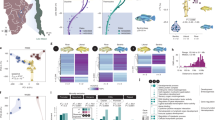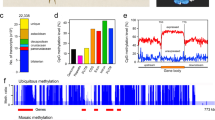Abstract
Phenotypic responses to the environment may be controlled via cytosine methylation (5mC) and its effects on gene expression. We test whether hypoxia influences plastic or heritable changes in the quantity of 5mC in the genomes of a widespread African cichlid, the Egyptian mouth-brooder, Pseudocrenilabrus multicolor (Schöller, 1903). Fish were collected from three sites in southwestern Uganda: one hypoxic swamp, one swamp-river ecotonal area, and one well-oxygenated river site. F1 offspring were raised in a split-brood experiment under both high- (normoxic) and low-oxygen (hypoxic) conditions. Previous work on morphological and physiological variation that stemmed from this experiment showed that the majority of responses to hypoxia were plastic, with some genetic variation in plasticity observed among populations. To partition evolutionary and plastic effects on 5mC, we estimated the percentage of methylated cytosines in the genomes of the muscle, gills, and brain. Our results showed that the quantity of 5mC varied among tissues, and there were significant differences between rearing treatments for the gills in families from the swamp site, with higher cytosine methylation levels under hypoxic laboratory conditions. No other significant differences were observed, but more extensive sampling schemes, as well as contrasting genomic 5mC patterns to transcriptional variation, could shed additional light on the molecular basis of plasticity in response to hypoxia.



Similar content being viewed by others
References
Andersen IS, Lindeman LC, Reiner AH, Østrup O, Aanes H, Aleström P et al (2013) Epigenetic markings of the zebrafish developmental program. In: Heard E (ed) Epigenetics and development. Academic Press, London, pp 85–112
Angers B, Castonguay E, Massicotte R (2010) Environmentally induced phenotypes and DNA methylation: how to deal with unpredictable conditions until the next generation and after. Mol Ecol 19:1283–1295. https://doi.org/10.1111/j.1365-294X.2010.04580.x
Asselman J, De Coninck DIM, Vandegehuchte MB, Jansen M, Decaestecker E, De Meester L et al (2015) Global cytosine methylation in Daphnia magna depends on genotype, environment, and their interaction. Environ Toxicol Chem 34:1056–1061. https://doi.org/10.1002/etc.2887
Baerwald MR, Meek MH, Stephens MR, Nagarajan RP, Goodbla AM, Tomalty KM, Thorgaard GH, May B, Nichols KM (2016) Migration-related phenotypic divergence is associated with epigenetic modification in rainbow trout. Mol Ecol 25:1785–1800. https://doi.org/10.1111/mec.13231
Berdasco M, Esteller M (2019) Clinical epigenetics: seizing opportunities for translation. Nat Rev Genet 20:109–127. https://doi.org/10.1038/s41576-018-0074-2
Bewick AJ, Hofmeister BT, Lee K, Zhang X, Hall DW, Schmitz RJ (2015) FASTmC: a suite of predictive models for nonreference-based estimations of DNA methylation. Genes Genom Genet 6:447–451. https://doi.org/10.1534/g3.115.025668
Chapman LJ, Galis F, Shinn J (2000) Phenotypic plasticity and the possible role of genetic assimilation: hypoxia-induced trade-offs in the morphological traits of an African cichlid. Ecol Lett 3:387–393. https://doi.org/10.1046/j.1461-0248.2000.00160.x
Crispo E (2007) The Baldwin effect and genetic assimilation: revisiting two mechanisms of evolutionary change mediated by phenotypic plasticity. Evolution 61:2469–2479. https://doi.org/10.1111/j.1558-5646.2007.00203.x
Crispo E, Chapman LJ (2008) Population genetic structure across dissolved oxygen regimes in an African cichlid fish. Mol Ecol 17:2134–2148. https://doi.org/10.1111/j.1365-294X.2008.03729.x
Crispo E, Chapman LJ (2010) Geographic variation in phenotypic plasticity in response to dissolved oxygen in an African cichlid fish. J Evol Biol 23:2091–2103. https://doi.org/10.1111/j.1420-9101.2010.02069.x
Crispo E, Chapman LJ (2011) Hypoxia drives plastic divergence in cichlid body shape. Evol Ecol 25:949–964. https://doi.org/10.1007/s10682-010-9445-7
Crocker CD, Chapman LJ, Martínez ML (2013) Hypoxia-induced plasticity in the metabolic response of a widespread cichlid. Comp Biochem Physiol B 166:141–147. https://doi.org/10.1016/j.cbpb.2013.08.002
Dubin MJ, Zhang P, Meng D, Remigereau M-S, Osborne EJ, Casale FP et al (2015) DNA methylation in Arabidopsis had a genetic basis and shows evidence of local adaptation. eLife 4:e05255. https://doi.org/10.7554/eLife.05255
Dunican DS, Pennings S, Meehan RR (2015) Lsh is essential for maintaining global DNA methylation levels in Amphibia and fish and interacts directly with Dnmt1. Biomed Res Int: Article ID 740637. https://doi.org/10.1155/2015/740637
Eichten SR, Schmitz RJ, Springer NM (2014) Epigenetics: beyond chromatin modifications and complex genetic regulation. Plant Physiol 165:933–947. https://doi.org/10.1104/pp.113.234211
Feng S, Cokus SJ, Zhang X, Chen P-Y, Bostick M, Goll MG, Hetzel J, Jain J, Strauss SH, Halpern ME, Ukomadu C, Sadler KC, Pradhan S, Pellegrini M, Jacobsen SE (2010) Conservation and divergence of methylation patterning in plants and animals. Proc Natl Acad Sci U S A 107:8689–8694. https://doi.org/10.1073/pnas.1002720107
Gracey AY, Troll JV, Somero GN (2001) Hypoxia-induced gene expression profiling in the euryoxic fish Gillichthys mirabilis. Proc Natl Acad Sci U S A 98:1993–1998. https://doi.org/10.1073/pnas.98.4.1993
Hammond SA, Nelson CJ, Helbing CC (2016) Environmental influences on the epigenomes of herpetofauna and fish. Biochem Cell Biol 94:95–100. https://doi.org/10.1139/bcb-2015-0111
Head JA (2014) Patterns of DNA methylation in animals: an ecotoxicological perspective. Integr Comp Biol 54:77–86. https://doi.org/10.1093/icb/icu025
Hebels DGAJ, Georgiadis P, Keun HC, Athersuch TJ, Vineis P, Vermeulen R, Portengen L, Bergdahl IA, Hallmans G, Palli D, Bendinelli B, Krogh V, Tumino R, Sacerdote C, Panico S, Kleinjans JC, de Kok TM, Smith MT, Kyrtopoulos SA, EnviroGenomarkers Project Consortium (2013) Performance in omics analyses of blood samples in long-term storage: opportunities for the exploitation of existing biobanks in environmental health research. Environ Health Perspect 121:480–487. https://doi.org/10.1289/ehp.1205657
Jones PA (2002) Functions of DNA methylation: islands, start sites, gene bodies and beyond. Nat Rev Genet 13:484–493. https://doi.org/10.1038/nrg3230
Keller TE, Lasky JR, Yi SV (2016) The multivariate association between genomewide DNA methylation and climate across the range of Arabidopsis thaliana. Mol Ecol 25:1823–1837. https://doi.org/10.1111/mec.13573
Kim B-M, Mirbahai L, Mally A, Chipman JK, Rhee J-S, Lee J-S (2016) Correlation between the DNA methyltransferase (Dnmt) gene family and genome-wide 5-methylcytosine (5mC) in rotifer, copepod, and fish. Genes Genom 38:13–23. https://doi.org/10.1007/s13258-015-0333-y
Lamarck JB (1809) Philosophie Zoologique. Museum d’Histoire Naturelle, Paris
Martínez ML, Chapman LJ, Rees BB (2009) Population variation in hypoxic responses of the cichlid Pseudocrenilabrus multicolor victoriae. Can J Zool 87:188–194. https://doi.org/10.1139/Z09-002
Nikinmaa M, Rees BB (2005) Oxygen-dependent gene expression in fishes. Am J Phys Regul Integr Comp Phys 288:R1079–R1090. https://doi.org/10.1152/ajpregu.00626.2004
Ptashne M (2007) On the use of the word ‘epigenetic’. Curr Biol 17:R233–R236. https://doi.org/10.1016/j.cub.2007.02.030
Putnam HM, Davidson JM, Gates RD (2016) Ocean acidification influences host DNA methylation and phenotypic plasticity in environmentally susceptible corals. Evol Appl 9:1165–1178. https://doi.org/10.1111/eva.12408
R Core Team (2019) R: A language and environment for statistical computing. R Foundation for Statistical Computing, Vienna, Austria. URL http://www.R-project.org/
Rimoldi S, Terova G, Ceccuzzi P, Marelli S, Antonini M, Saroglia M (2012) HIF-1α mRNA levels in Eurasian perch (Perca fluviatilis) exposed to acute and chronic hypoxia. Mol Biol Rep 39:4009–4015. https://doi.org/10.1007/s11033-011-1181-8
Robertson M, Schrey A, Shayter A, Moss CJ, Richards C (2017) Genetic and epigenetic variation in Spartina alterniflora following the Deepwater Horizon oil spill. Evol Appl 10:792–801. https://doi.org/10.1111/eva.12482
Rytkönen KT, Prokkola JM, Salonen V, Nikinmaa M (2014) Transcriptional divergence of the duplicated hypoxia-inducible factor alpha genes in zebrafish. Gene 541:60–66. https://doi.org/10.1016/j.gene.2014.03.007
Skinner MK (2014) Environmental stress and epigenetic transgenerational inheritance. BMC Med 12:153–155. https://doi.org/10.1186/s12916-014-0153-y
Smith G, Smith C, Kenny JG, Chaudhuri RR, Ritchie MG (2014) Genome-wide DNA methylation patterns in wild samples of two morphotypes of threespine stickleback (Gasterosteus aculeatus). Mol Biol Evol 32:888–895. https://doi.org/10.1093/molbev/msu344
Smith RWA, Monroe C, Bolnick DA (2015) Detection of cytosine methylation in ancient DNA from five native American populations using bisulfite sequencing. PLoS One 10:e0125344. https://doi.org/10.1371/journal.pone.0125344
Smith TA, Martin MD, Nguyen M, Mendelson TC (2016) Epigenetic divergence as a potential first step in darter speciation. Mol Ecol 25:1883–1894. https://doi.org/10.1111/mec.13561
Suzuki MM, Kerr ARW, De Sousa D, Bird A (2007) CpG methylation is targeted to transcription units in an invertebrate genome. Genome Res 17:625–631. https://doi.org/10.1101/gr.6163007
Tiedke J, Thiel R, Burmester T (2014) Molecular response of estuarine fish to hypoxia: a comparative study with ruffe and flounder from field and laboratory. PLoS One 9:e90778. https://doi.org/10.1371/journal.pone.0090778
Tollefsbol TO (2018) Epigenetics of human disease. In: Tollefsbol TO (ed) Epigenetics in human disease, 2nd edn. Academic Press, Cambridge, pp 3–10. https://www.sciencedirect.com/science/article/pii/B9780128122150120011
Trucchi E, Mazzarella AB, Gilfillan GD, Lorenzo MT, Schönswetter P, Paun O (2016) BsRADseq: screening DNA methylation in natural populations of non-model species. Mol Ecol 25:1697–1713. https://doi.org/10.1111/mec.13550
Vandegehuchte MB, Janssen CR (2011) Epigenetics and its implications for ecotoxicology. Ecotoxicology 20:607–624. https://doi.org/10.1007/s10646-011-0634-0
Verhoeven KJF, Vonholdt BM, Sork VL (2016) Epigenetics in ecology and evolution: what we know and what we need to know. Mol Ecol 25:1631–1638. https://doi.org/10.1111/mec.13617
Waddington CH (1942) Canalization of development and the inheritance of acquired characters. Nature 3811:563–565. https://doi.org/10.1038/150563a0
Acknowledgements
We thank Robert Schmitz and staff at The University of Georgia’s genomics core facility for performing the sequencing and running the FASTmC predictive models.
Funding
The work was supported via start-up funds from Pace University to E. Crispo.
Author information
Authors and Affiliations
Corresponding author
Ethics declarations
Conflict of interest
The authors declare no conflicts of interest.
Ethical approval
All applicable guidelines for the care and use of animals were followed. All procedures performed involving animals were in accordance with the ethical standards of McGill University at which the part of the study involving animal care and euthanasia was conducted (McGill University Animal Care Committee Protocol #5029). This article does not contain any studies with human participants performed by any of the authors.
Additional information
Publisher’s note
Springer Nature remains neutral with regard to jurisdictional claims in published maps and institutional affiliations.
Electronic supplementary material
ESM 1
(CSV 2 kb)
Rights and permissions
About this article
Cite this article
Crispo, E., Suman, P.D. & Chapman, L.J. Quantifying genome-wide cytosine methylation in response to hypoxia in the gills, muscle, and brain of an African cichlid fish. Environ Biol Fish 103, 223–232 (2020). https://doi.org/10.1007/s10641-020-00948-x
Received:
Accepted:
Published:
Issue Date:
DOI: https://doi.org/10.1007/s10641-020-00948-x




